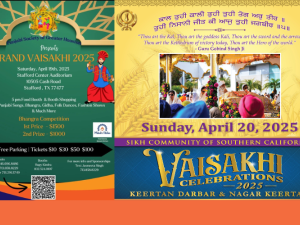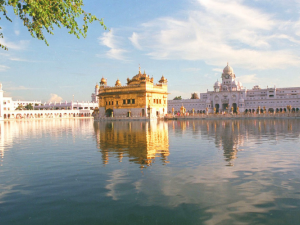Turban
Turban is an English word which refers to a length of cloth wrapped around the head. Different styles of Turbans are worn by people around the world, and may vary by region and country. The turban is a distinct aspect of Sikh identity. Within the Sikh Faith, there are several distinct styles worn by both Sikh men and women. The turban is an important part of a Sikh’s traditional attire and martial history. The turban has practical as well as spiritual significance. On the battlefield, a turban served as a type of flexible helmet. A tightly wrapped turban of many layers prevented penetration by arrows, maces, musket balls, spears, and swords. The turban kept a Sikh's warriors’ long hair from obscuring vision and out of the enemy's reach.
General History of Turban
Turbans date back thousands of years, quite likely as far as woven cloth. Although the exact origin is unknown, a Mesopotamian royal sculpture dated 2350 BCE depicts a turban-like head wrap. The Bible whose scripture is believed to document 6000 years of history describes a turban as a part of ceremonial attire worn by a Jewish high priest at least 4000 years ago. From 184 to 205 CE, Chinese peasants wearing yellow head cloths revolted against the Eastern Han Dynasty during the reign of Emperor Ling in what is known as the Yellow Turban Rebellion. Ancient Buddhist art about 300 CE depicts a topknot covered by a small turban cloth. Soldiers of the Byzantine army wore a type of military turban from 400 to 600 CE. The prophet Mohammed (570 – 632 CE) is believed to have worn a kind of white turban wound around a skull cap. Turbans became popular in parts of Africa, Europe, India, and Middle Eastern Arabic countries. In some Regions turbans could be worn only by royalty, and in some places a particular color designated the faith of the wearer.
History of Sikh Turban
In Ancient India the turban became a show of status. India’s rulers, chief officials, and high caste priests wore turbans, forbidding it to be worn by lower caste people. Mughal invaders decreed during the 16th century that only Islamic rulers and officials be allowed the privilege of wearing a turban. Beginning with Guru Nanak, all of the Sikh Gurus wore turbans, as did many of their followers. The Sikh turban became a symbol of equality defying caste and privilege. Fifth Guru Arjan Dev stood against ruling class oppression stating that, “Mughals wear a single turban, we shall wear two.” Hence the Dumalla, a kind of double turban worn one over the other, became popular with Sikh warriors. In 1669 CE, Tenth Guru Gobind Singh formally established the initiated Khalsa Warriors sect, making the turban mandatory attire for all Sikhs.
Historic Importance of Turban in Sikh Scripture & Conduct
The turban is mentioned by various authors in several different Sikh scriptures and panthik conduct codes including:
Guru Granth Sahib has 8 verses where “turban” appears. Examples include:
- Mai gur mil uch dumaalarhaa ||
I met with the Guru, and I have tied a tall, plumed turban.
Guru Granth Sahib Ji 74 – Guru Arjan Dev Ji Sri Raag
- Khoob teree pagaree meetthe tere bol ||
How handsome is your turban! And how sweet is your speech.
Guru Granth Sahib Ji – 727 Bhagat Naam Dev Ji Raag Tilang
Dasam Granth by Guru Gobind Singh mentions Turban at least 47 times. Examples include references to battles:
- Asai mutakaa chaar dumalian haannan ||
Their necklaces of gems glistened and their turbans looked graceful on the heads of both the warriors of the same age.
Dasam Granth Sahib || 146 – Guru Gobind Singh Ji
- Laal kare patt pai ddar kesar rang bhare pratinaa pat kaise ||
The forces of both sides moved for mutual union all of them had tied red turbans and they looked very impressive filled with joy and gaiety
Dasam Granth Sahib || 292 – Guru Gobind Singh
Panthik writings and codes include Bhai Gurdas Varaan, Rehitnama, a required conduct and wear, and Tankahnama, a disciplinary code of Guru Gobind Singh, and the modern-day Sikh Rehit Maryada (SRM) Code of Conduct & Conventions. Examples include:
- Sir uchaa ahnkaar kar val de pag valaae dderee|
The head being proud of its high place is tied with turban.
Bhai Gurdas Ji Vaaran | 23 – Bhai Gurdaas Ji
- Kaghaa karad dastareh baandhe||65||
Always keep the Kanga (comb) and Karad (knife) tied into your Turban.
Rehitnama || 65 – Bhai Nand Lal Ji
- Kanghaa karad dastaar sajaavai||
Wear the Kanga and a knife in your Turban.
Rehitnama|| 67 – Bhai Nand Lal Ji
- Sorttaa
Kangaa dovae vakat kar pugg chunai kar bandhaee||
Comb the hair and wrap the turban around in folded layers twice daily.
Tankaah Naamaa 7 ||23 – Bhai Nand Lal
(s) A Sikh woman must not veil her face.
(t) A Sikh man must wear Kachhera undergarment and Turban. A Sikh woman may choose to wear a turban [or scarf implied by customs of the era 1936 CE]
Sikh Rehit Maryada Section 4, Chapter X Article XVI page 24







